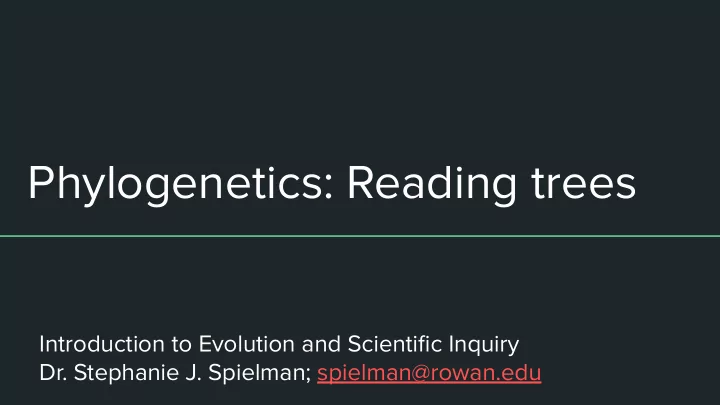

Phylogenetics: Reading trees Introduction to Evolution and Scientific Inquiry Dr. Stephanie J. Spielman; spielman@rowan.edu
Cladogenesis: birth of new clades Extinct New species ancestor one species New species two Time
The first ever phylogeny
Systematics, Cladistics, Phylogenetics ● Systematics: The study of diversity of life and identification of taxa (singular: taxon) ● Cladistics: The systematic classification of groups of organisms using shared characteristics derived from a common ancestor Phylogenetics: The science of creating evolutionary trees that reveal how organisms are ● related to each other, based on common ancestry
The Linnaean Hierarchy
Anatomy of a phylogeny
Anatomy of a phylogeny
Sister taxa or clades share a common ancestor A and B are sister taxa (A,B) and (C,D) are sister clades Who is E sister to?
Read trees by tracing back through branches MRCA = Most Recent Common Ancestor The more recently your MRCA, the more closely you are related.
Angled or boxy shapes are still the same. It's all about tracing through nodes!!
Each box contains the same tree drawn two different ways
Trees are fundamentally a bunch of nested trees
The tree-thinking challenge!
Components of a phylogeny ● Topology : the branching patterns Branch lengths can represent a variety of things (you'll be told!) ● ○ Nothing at all ("Cladogram") ○ Evolutionary distance (genetic change) ○ Time since divergence ● Confidence measures at nodes (usually scaled 0-100) ○ Statistical quantity with complex interpretation. ROUGHLY means: How confident are we that this node is correct? Interpreted as, >70 pretty confident.
Branch lengths show evolutionary distance
More flaviviruses
Time-scaled branch lengths, for example
Our place in the tree of life
The eukaroytic tree of life
The Metazoan tree of life (animals!)
Vertebrate tree of life (ignore marker dots at nodes)
Mammalian tree of life
The primate tree of life (ignore branch colors)
Recommend
More recommend